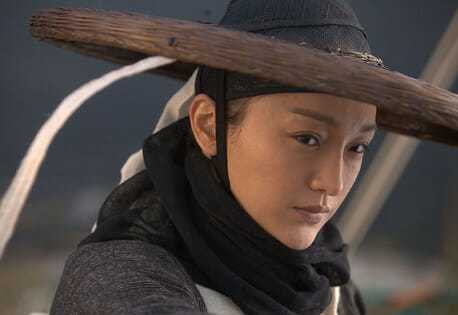
As the first Chinese movie to be shot in IMAX 3D, Flying Swords of Dragon Gate marks a high-tech milestone for both China and for Tsui Hark, veteran director of three decades worth of martial-arts sagas. Hark’s latest collaboration with superstar Jet Li is packed with breakneck, high-wire fight sequences and exquisite production design. But it’s all nearly undone by overwrought plotting and the 3D technology being used as its prime selling point.
As with nearly all 3D enterprises, the gimmick hinders our full appreciation of the movie’s production. In scene after scene, the images are too dark and the points of focus distort and shift depending on the angle of the viewer’s eyes to the screen. So it’s ironic that—even with the screen’s massive proportions—we still cannot marvel at Hark’s production design and aerial stunt work to the degree they deserve.
Powered by a rousing score, Flying Swords opens with sweeping, CGI-created vistas of an ancient Chinese waterfront kingdom. As is the case throughout the movie, it’s the majesty of the IMAX-sized imagery that pulls us into the scene while the 3D only manages to distract. Hark’s spectacular opening, complete with a full-throttle action scene, is his introduction to a story about Chow Wai On (Li), a crusading swordsman, tracking Yu Hua Tian (Chen Kun), a nefarious imperial spy. Yu is himself on the hunt for a fugitive concubine (Mavis Fan) and Jade (Zhou Xun), her mysterious guardian. The parties converge at the shambolic Dragon Gate Inn, an outpost on the desert frontier, where they also encounter a gang of Tartar mercenaries and a pair of fortune hunters, all of whom get wind of a fabled golden city, laden with treasure, buried in the sands nearby.
From that point on, Hark’s script becomes a convoluted tangle of alliances, unrequited romance, mistaken identities and intrigue as the Tarters fall in with the fortune hunters and with Chow and Jade, former flames struggling to keep their emotions in check, as they plot to defeat Yu and his gathering cavalry. All the while, the skies are a cauldron brewing up the mother of all sandstorms. When one of the fortune hunters realizes he’s a dead ringer for Yu and Jade reveals herself to be more than a little familiar with the Inn’s secret tunnels and hideouts, the plot points set off another round of dizzying—and tedious —turns and twists, everything leading to a protracted faceoff inside the long sought-after golden city.
Hark’s juggling of multiple scenarios, each punctuated by showdowns and stand-offs, can be a mess to follow and all seem beside the point. Flying Swords’ appeal lies in its performances, style and design. Li makes for a magnetic presence as the stoic swordsman, and everyone in the charismatic ensemble is adroitly up to the physical challenges of the material. When the shots stay put and the distortions of 3D don’t play havoc with the image, one can really soak up the immaculate detailing of the sets and costumes. And, for the most part, Hark distinguishes his action scenes with striking imagery—the airborne fight inside a monster tornado during the storm sequence being the highlight.
While the technology is a dampener and the plotting burdensome, Flying Swords has enough charm and pizzazz to merit a good time at the movies. Fans of Jet Li, martial-arts cinema and of Hark’s epics, in particular, won’t be disappointed. And for those just as pained by ineptly executed 3D as this reviewer, one consolation is that the movie’s virtues are destined to be admired the old-fashioned way—on spectacular 2D—long after the current 3D fad goes the way of, well, itself in the 1950s.
Director: Tsui Hark
Writer: Tsui Hark
Starring: Jet Li, Zhou Xun, Chen Kun, Li Yuchun, Kwai Lun-Mei, Mavis Fan, Fan Siu-Wong
Release Date: Aug. 31, 2012